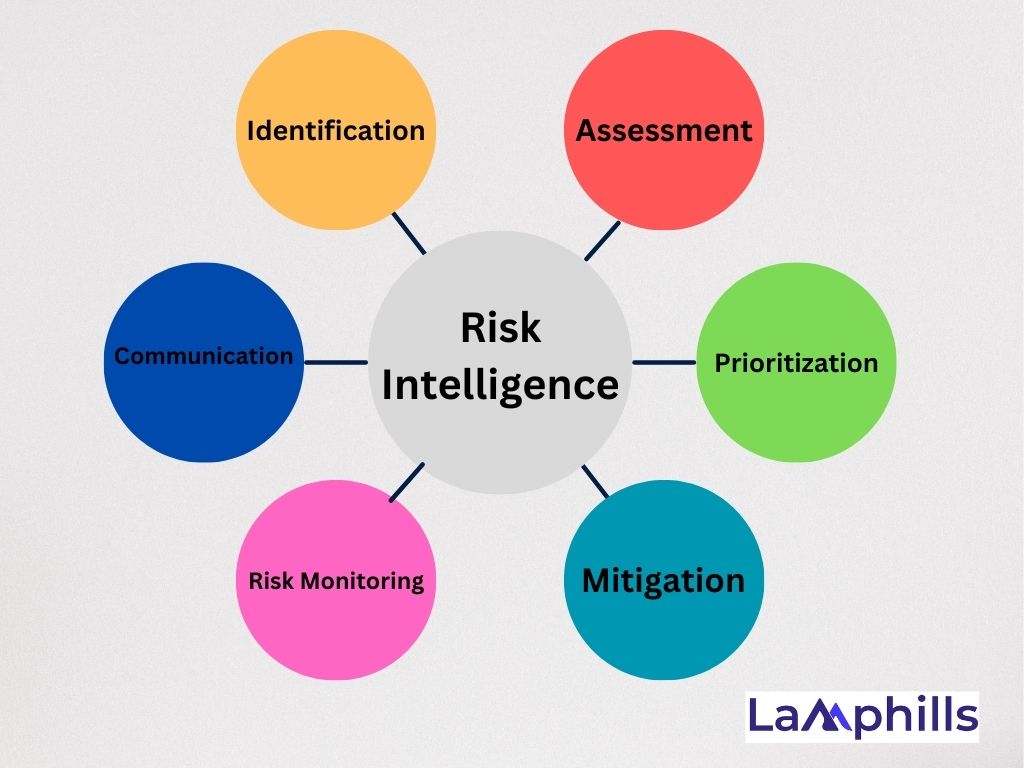Risk intelligence is an important aspect of operational risk management. Many companies have improved their capacity for identifying and responding to risks by incorporating the risk identification and analysis process. What is risk intelligence, then, and why should you consider it? Read on.
Key Takeaways
- Risk intelligence involves gathering information to identify risks and devise means to mitigate such risks
- The elements of risk management include risk identification, risk assessment, risk prioritization, risk mitigation, risk monitoring, and communication
What Is Risk Intelligence?
Risk intelligence involves gathering information to identify risks. Information on potential risks can help your company identify challenges that could deter success and devise ways to mitigate such risks. As a vital aspect of risk management, you can avoid risks entirely or minimize losses from their occurrence. You can also align your business strategy with risk management; I’ll explain this as we go on. First, let’s look at the elements of risk intelligence…
Elements Of Risk Intelligence

The elements of risk intelligence play a crucial role in helping your organization identify and manage risks. They include:
- Risk identification: Analyzing and obtaining information on factors that could create risk.
- Risk assessment: Evaluating the likelihood that a risk might occur. It involves analyzing the possibilities of risk and the potential consequences that might follow.
- Risk prioritization: Categorizing each risk in order of importance. It involves organizing risks based on their importance to the organization.
- Risk mitigation: Developing and implementing strategies that reduce the likelihood of a risk occurring. It involves implementing regulations, developing contingency plans, or transferring risk.
- Risk monitoring: Reviewing the effectiveness of risk management activities. It involves tracking risk indicators and evaluating the overall risk management process.
- Risk communication: Sharing information about risks with company stakeholders. Here, you outline risks and management strategies for investors, executives, and other interested parties.
Importance Of Risk Intelligence
Why is risk intelligence important? you may ask. We have already established that risk intelligence is important to operational risk management. When even a single risk can compromise your company’s success, risk intelligence can help you identify and respond promptly to risks.
You can collect data and information on your company’s risks using several methods. These methods include website audits, internal data analyses, external research, or expert advice. These insights give you a wide perspective on your company’s challenges. And with them, you can develop risk management strategies.
In essence, risk intelligence empowers organizations to confidently embrace uncertainty, turning potential threats into opportunities for growth and innovation. By understanding risk intelligence and integrating it into your organization’s decision-making processes, you can navigate turbulent waters with resilience and foresight.
Differentiating Risk Intelligence from Traditional Approaches
Traditional risk management approaches tend to be reactive; they focus on identifying and mitigating known risks after they’ve surfaced. On the other hand, risk intelligence is proactive; it looks to identify sources of potential risks and develop strategies to mitigate them before they escalate.
I remember when our team faced a major product recall due to a quality control oversight. While traditional risk management would have entailed damage control and mitigation efforts post-crisis, adopting risk intelligence allowed us to detect the issue early enough. Thus, we took swift corrective action and minimized the impact on our reputation.
Building a Risk Intelligence Framework: A Personal Perspective
As a risk management professional, I’ve learned the importance of building an intriguing risk intelligence framework within organizations. I’ll share some of the insights here:
Identifying Potential Risks
During my tenure at a global corporation, we faced many risks, from market volatility to cybersecurity threats. We conducted comprehensive risk assessments across all departments to effectively identify these risks. One memorable instance was when we uncovered a potential supply chain disruption due to geopolitical tensions. This proactive identification enabled us to swiftly develop contingency plans and minimize the impact on our operations.
Assessing Risks and Establishing Tolerance Levels
Once you’ve identified these risks, the next step is to assess their potential impact and likelihood. By conducting thorough risk assessments and stress tests, you can determine your risk tolerance levels and make informed decisions regarding the project’s feasibility. This approach will safeguard your financial resources and enhance stakeholder confidence in your risk management capabilities.
Developing Risk Mitigation Strategies
Of course, the next step after identification and assessment is action. In this case, it is developing strategies to mitigate potential negative impacts from identified risks.
Data Collection and Analysis In Risk Intelligence
Data collection and analysis are indispensable tools in risk management. By harnessing the power of data analytics tools and techniques, you can gain valuable insights into potential risks, identify emerging patterns and trends, and make informed decisions that drive success.
Benefits of Integrating Data Analytics in Risk Intelligence Analysis

#1. Improved Risk Identification
Data analytics helps risk intelligence analysts identify risks more accurately by analyzing large datasets from different sources. Analysts can identify emerging risks, detect irregularities, and proactively address potential threats by implementing advanced analytics techniques, such as anomaly detection and pattern recognition.
#2. Early Warning and Predictive Analytics
Risk intelligence analysts can foresee hazards and issue early warnings with data analytics. Using predictive analytics methods such as data mining and machine learning, analysts can spot trends, patterns, and possible risk indicators that could be signs of impending danger. With this proactive approach, organizations can take preventive action and reduce hazards before they escalate.
#3. Enhanced Risk Assessment Accuracy
By leveraging historical data, statistical analysis, and predictive modeling, analysts can more precisely quantify the likelihood and impact of risks, enabling organizations to prioritize their risk mitigation efforts effectively.
#4. Real-Time Monitoring and Detection
Risk intelligence analysts can monitor and identify threats in real-time with data analytics. By utilizing automated monitoring systems and real-time data streams, analysts can spot irregularities, look for new patterns, and take quick action in the event of a threat. Because of their agility, firms can quickly reduce risks and lessen their impact on operations and reputation.
#5. Data-Driven Decision Making
Integrating data analytics into risk intelligence analysis enables evidence-based decision-making. By leveraging data-driven insights, analysts can provide actionable recommendations to key stakeholders, enabling them to make informed decisions regarding risk mitigation strategies, resource allocation, and operational improvements.
Risk Communication and Reporting
Effective communication and reporting are vital in risk management. With these clear strategies, you can empower stakeholders and decision-makers to navigate uncertainties confidently:
#1. Developing Communication Strategies
Tailor communication strategies to meet stakeholders’ needs. Whether you’re communicating cybersecurity threats to IT teams or financial risks to executives, understanding their preferences ensures messages resonate and drive action.
#2. Crafting Comprehensive Risk Reports
Compile detailed yet accessible risk reports. Drawing upon data analysis and assessments, provide insights into emerging risks, mitigation strategies, and potential impacts on objectives. Structured, digestible information empowers informed decision-making.
#3. Incorporating Clarity and Transparency
Transparency and clarity are essential in communication. Stakeholders rely on accurate, timely information. Fostering open communication builds trust, even amid uncertainty.
Incorporating Risk Intelligence Into Decision-making

Integrating risk intelligence into decision-making processes is crucial for proactive risk management and strategic planning. Here’s how you can empower yourself and your team with risk intelligence:
- Conduct comprehensive risk assessments and scenario analyses to identify potential risks and opportunities.
- Use the insights to inform strategic priorities, resource allocation strategies, and long-term planning initiatives.
- Integrating risk considerations into every phase of the strategic planning process allows for proactive anticipation of challenges and capitalization on emerging trends.
Empowering Employees with Risk Intelligence
- Provide targeted training programs and communication initiatives to educate employees about risk management principles and practices.
- Encourage risk awareness and accountability by empowering teams to assess risks autonomously and integrate risk considerations into their daily decision-making processes.
- Foster a mindset of continuous improvement and innovation by embracing risk as an opportunity for growth rather than a threat to be avoided.
Integrating risk intelligence into decision-making processes is a strategic imperative for modern organizations. By incorporating risk considerations into strategic planning and empowering employees with the tools and knowledge to make informed decisions, you can proactively manage risks, capitalize on opportunities, and drive sustainable growth.
Implementing a Successful Risk Intelligence Strategy
Successful risk intelligence requires a systematic, structured approach. Here are some tips for achieving the best results:
#1. Define your objectives
This is the first step in implementing almost any strategy. Identify set goals and create a roadmap that’ll help you achieve them. By doing this, you gain clarity on what your program should achieve. This will also guide company decision-making and ensure that company resources are used effectively.
#2. Identify Relevant Information Sources
Determine the scope of your program. Identify the risks you might face and the stakeholders you will report to. Next, review all internal and external data sources, including incident reports, audits, and risk maps. This information lets you identify areas where risks were stopped, slowed, or managed effectively.
#3. Monitor and Assess Risks
You can identify any new or emerging risks in your company with continuous risk monitoring and assessment. With this, you can observe how familiar risks occur and how to mitigate them.
#4. Leverage Technology
Risk intelligence is a complicated field. You’ll do well using software to create a faster, more accurate risk strategy. The same software can also help educate employees on current best practices around risk management.
Here’s a detailed checklist for your reference:
Navigating Future Trends and Challenges in Risk Intelligence
As organizations evolve in response to changing market dynamics and technological advancements, risk intelligence and risk management continue to undergo transformation. Here’s a look at the future trends and challenges that are shaping the field:
#1. Advanced Analytics and AI
Integrating advanced analytics and artificial intelligence (AI) technologies will revolutionize risk intelligence, enabling organizations to leverage big data and predictive analytics to anticipate emerging risks and opportunities.
#2. Real-Time Monitoring
With the proliferation of IoT devices and sensors, real-time monitoring of risk factors will become more prevalent, allowing organizations to detect and respond to potential threats with greater agility and precision.
#3. Cybersecurity Threats
As digital transformation accelerates, cybersecurity threats will continue to evolve, posing significant challenges for organizations seeking to safeguard sensitive data and protect against cyber attacks.
#4. Regulatory Compliance
Heightened regulatory scrutiny and increased focus on corporate governance will drive organizations to adopt more robust risk management frameworks and compliance strategies to mitigate regulatory risks.
What Is Risk Intelligence In Business?
Risk intelligence in business refers to gathering, analysing, and utilising information to identify, assess, and mitigate potential risks that may impact organizational objectives. This enables informed decision-making and proactive risk management.
What Does A Risk Intelligence Analyst Do?
A risk intelligence analyst identifies, assesses, and mitigates potential organizational risks by analyzing data, monitoring trends, and providing insights to inform strategic decisions and minimize threats.
What Are The Four Main Types Of Business Risk?
The four main types of business risk are strategic, financial, operational, and compliance risks.
What Is Intelligent Risk In Entrepreneurship?
Intelligent risk in entrepreneurship involves calculated decision-making, leveraging data and insights to identify opportunities, mitigate potential threats, and maximize the likelihood of success while minimizing potential losses.
How Do I Become An Intelligence Analyst?
To become an intelligence analyst, acquire a relevant degree, develop critical thinking and analytical skills, gain experience through internships or entry-level positions, and pursue certifications or advanced education for career advancement.
What Is Predictive Risk Analysis?
Predictive risk intelligence utilizes data analysis and machine learning to forecast potential risks before they occur, enabling proactive risk mitigation strategies.
What Does An Intelligence Officer Do?
Intelligence officers gather, analyze, and disseminate information to support decision-making. They conduct surveillance, assess threats, and provide insights for national security and policy formulation.






